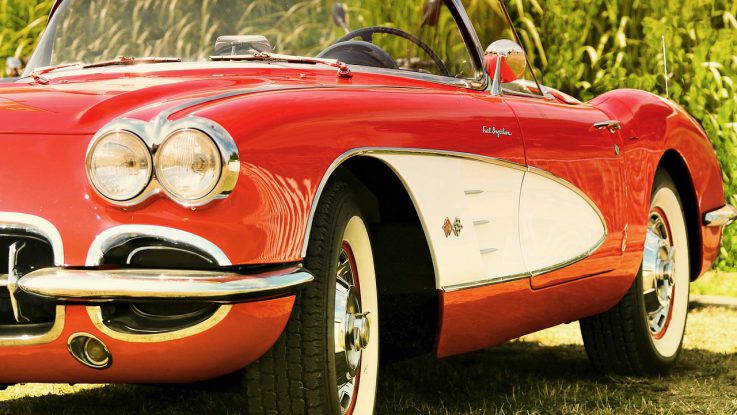
Cars have been around for over a century and, in that time, became an iconic part of our cultural heritage. As they get older, they become more valuable and get antique status.
So, how old does a car have to be to get an antique tag? Buckle up because we’re about to learn a lot about antique vehicles!
How Old Does a Car Have to Be to Be an Antique?
First things first, there isn’t a one-size-fits-all answer. Depending on who you ask, you may get different answers. The Antique Automobile Club of America gives us a simple solution — any car over 25 years old is an antique. However, some dealers may disagree, arguing that only vehicles over 45 years deserve the antique label.
How Old Does a Car Have to Be to Get an Antique Tag?

The antique tag is like a VIP pass for your vehicle. It’s a special license plate showing everyone your car is a collector’s item and lets you drive it on the road with a few restrictions.
The age limit for the antique tag varies by state, but in most cases, your car has to be at least 25 years old. So, if your vehicle was made in 1998 or earlier, it could be eligible for one of these special tags. However, in some states, like Florida, only cars over 30 qualify for the antique license plate.
So, what’s so special about these tags?
For starters, you get to drive your antique car on the road. But this comes with some restrictions, like mileage limit. Since people don’t usually drive antique cars as often as regular cars, they’re considered more valuable and need to be protected.
Another perk is that you could save on car insurance because your vehicle is seen as a collector’s item, not a daily driving engine.
There are some downsides, too. For example, depending on where you live, you might have to deal with extra inspections or emissions tests. And the worst part is that you may not be able to take your antique car on a cool road trip because there could be restrictions on where and how far you are allowed to drive it.
Antique Car Insurance
Why do antique cars need special insurance?
Antique car insurance is a thing because these cars are worth a lot more and can be a pain to fix or replace a part if something goes wrong. Plus, most of these old-school cars don’t have modern safety features. The lack of these safety measures means your antique car could be irreversibly damaged if you get in a wreck. Of course, the same risk applies to human safety, too.
You need to have the right type of insurance coverage to protect your car. Thankfully, there are insurance options specifically designed for antique vehicles.
One type of coverage is called “stated value” insurance. Essentially, stated value insurance lets you set a specific value for your car based on how rare it is, its condition, and other similar factors. That way, you know you’re covered if something happens and you need to repair or replace your car. In addition, with this insurance type, you’re fully compensated in the event of total loss.
Another option is called “agreed value” insurance, which is similar to “stated value” but involves negotiating and agreeing with the insurance company about the value beforehand. Consequently, this insurance type avoids disputes over your car if it’s damaged.
When shopping for antique car insurance, it’s a good idea to compare options from different providers and do plenty of research. It’s also a good idea to join a classic car club since some clubs offer insurance options for their members.
Specific requirements or restrictions apply to antique car insurance policies. For example, some policies require mileage limits or require particular storage conditions. Ask your insurance provider many questions. After all, protecting your vintage beauty is worth the extra effort.
Classic Car Club

Do you admire classic cars and wish you had a community of like-minded individuals to share your passion with? Then, look no further than a classic car club!
Classic car clubs are the ultimate pit stop for antique and hot rod car enthusiasts. Whether you’re the proud owner of a fully restored classic or a modified speed demon, a classic car club is the perfect place to hang out with others who share your interests, expertise, and love for timeless beauties.
Moreover, classic car clubs are not just a place to swap car stories and show off your car. You’ll also have access to a wealth of resources and information to help you maintain and restore your vehicle. Want to learn how to rebuild an engine or paint your car with a custom design? Many clubs offer workshops and seminars taught by experts in the field.
And let’s not forget about the best part. Classic car clubs often organize events like car shows, cruises, and rallies, where members can show off their cars, connect with other enthusiasts, and even win vehicle awards. We are not talking about some spare time hobby – it’s a whole lifestyle. You’ll join the community with people who understand and share your passion.
Difference Between Classic, Vintage, and Antique Cars
Many people use terms like classic, vintage, and antique cars interchangeably, but there are differences between these three types of cars.
Here is a general overview of the differences between these concepts.
Classic cars often have smooth curves and fancy interiors that scream luxury — picture shiny chrome accents and a sophisticated vibe that’s been stylish for decades. Made about 20 to 45 years ago, classic cars are still getting attention today.
Vintage cars, on the other hand, come straight out of the history books. Made way back between 1919 and 1930, they feature unique design features. Since they were built mainly by hand, you’ll notice the fancy grilles, rounded fenders, and exposed engines that you won’t find on any modern cars. Large headlights and tall, narrow tires also add to the old-world charm.
Finally, antique cars are like historical artifacts; collectors go wild for them. Antique cars are known for their unique design elements (simple and elegant lines with minimal ornamentation, brass and copper details, etc.), historical significance, and overall rarity. Some prime examples of antique cars include the Ford Model A, Duesenberg Model J, and the Mercedes-Benz 500K.
Conclusion
Determining when a car can be considered an antique isn’t as simple as it sounds. We are discussing a topic that still ignites heated debates and fuels arguments among car enthusiasts.
But, whether you’re a seasoned collector or simply an admirer of these timeless vehicles, one thing is clear: antique cars are treasures that have stood the test of time and continue to inspire awe in us to this day.
So, keep your eyes peeled for these historic beauties on the road, and don’t forget to give them the appreciation they deserve.

Leave a Reply